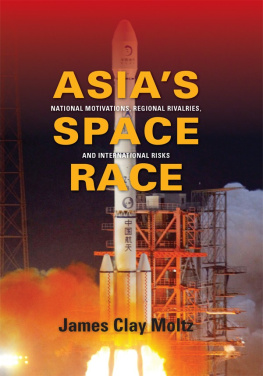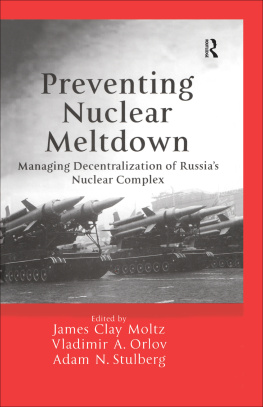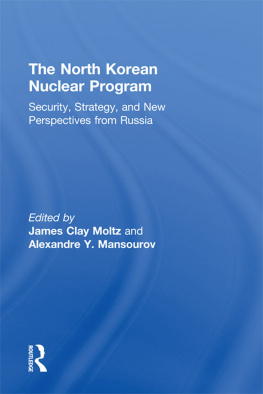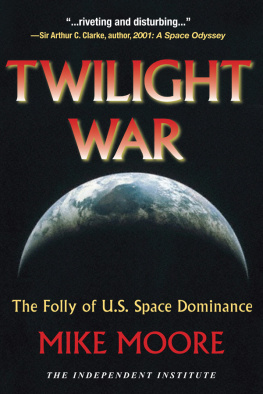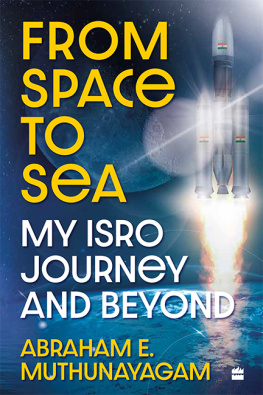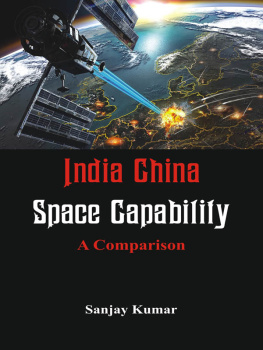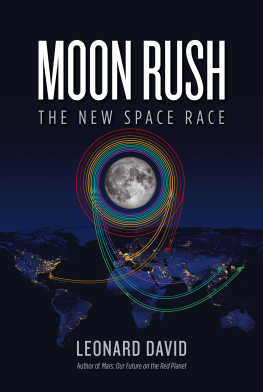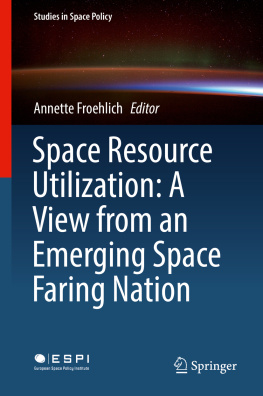ASIAS SPACE RACE
Contemporary Asia in the World
CONTEMPORARY ASIA IN THE WORLD
David C. Kang and Victor D. Cha, Editors
This series aims to address a gap in the public-policy and scholarly discussion of Asia. It seeks to promote books and studies that are on the cutting edge of their respective disciplines or in the promotion of multidisciplinary or interdisciplinary research but that are also accessible to a wider readership. The editors seek to showcase the best scholarly and public-policy arguments on Asia from any field, including politics, history, economics, and cultural studies.
Beyond the Final Score: The Politics of Sport in Asia, Victor D. Cha, 2008
The Power of the Internet in China: Citizen Activism Online, Guobin Yang, 2009
China and India: Prospects for Peace, Jonathan Holslag, 2010
India, Pakistan, and the Bomb: Debating Nuclear Stability in South Asia, umit Ganguly and S. Paul Kapur, 2010
Living with the Dragon: How the American Public Views the Rise of China, Benjamin I. Page and Tao Xie, 2010
East Asia Before the West: Five Centuries of Trade and Tribute, David C. Kang, 2010
Harmony and War: Confucian Culture and Chinese Power Politics, Yuan-Kang Wang, 2011
Strong Society, Smart State: The Rise of Public Opinion in Chinas Japan Policy, James Reilly, 2012
ASIAS SPACE RACE
National Motivations, Regional Rivalries, and International Risks
JAMES CLAY MOLTZ
COLUMBIA UNIVERSITY PRESS NEW YORK
Columbia University Press
Publishers Since 1893
New York Chichester, West Sussex
cup.columbia.edu
Copyright 2012 Columbia University Press
Paperback edition, 2018
All rights reserved
E-ISBN 978-0-231-15688-2
Library of Congress Cataloging-in-Publication Data
Moltz, James Clay.
Asias space race : national motivations, regional rivalries, and international risks / James Clay Moltz.
p. cm. (Contemporary Asia in the world)
Includes bibliographical references and index.
ISBN 978-0-231-15688-2 (cloth) ISBN 978-0-231-15689-9 (pbk.) ISBN 978-0-231-52757-6 (e-book)
1. Space raceAsia. 2. Astronautics and stateAsia. 3. Astronautics and stateUnited States. I. Title. II. Series.
TL789.8.A78M65 2011
629. 41095dc22 2011004616
A Columbia University Press E-book.
CUP would be pleased to hear about your reading experience with this e-book at .
CONTENTS
Preface
The subject of space competition in Asia remains highly topical. Since this books original publication in 2012, much has happened. Japan has increased its cooperation with the United States in such areas as space situational awareness, while increasing its military space budget and developing new civilian technologies, including the low-cost Epsilon launcher. China has continued to expand and modernize its space infrastructure: opening its Hainan Island launch site; putting into operation the Beidou position, timing, and navigation system; and expanding its constellations of civil and military satellites. China has also conducted additional tests of anti-satellite weapons. India has launched a successful Mars probe, expanded its military space cadre, and won contracts for U.S. commercial satellite launches. South Korea successfully launched its first satellite in 2013 on a joint-venture rocket with Russia, while also advancing its own commercial satellite-manufacturing business and working toward a larger, domestically produced, space-launch vehicle. Meanwhile, North Korea has launched two satellitesin 2012 and 2016but seems to have recently focused on its military missiles rather than space development, thus raising security tensions in the region. Other countries, including Australia, have developed more ambitious national space policies. New Zealand in particular has put itself on the map by opening a space launch facility, which hosts Rocket Labs Electron launcher. All of these developments provide evidence of the continued expansion of Asian space activity.
In issuing this paperback edition, I have not changed the arguments or updated the various chapters. The history and domestics contexts of these space programs and the nature of their existing rivalries have not changed, although the countries have continued to develop new space technologies and programs. My hope is that this book remains valuable as a foundational study for understanding subsequent Asian space developments.
James Clay Moltz
December 2017
The idea for this book emerged out of a project that John Logsdon of George Washington Universitys Space Policy Institute and I organized in 2006 and 2007with the support of the John D. and Catherine T. MacArthur Foundationto study regional perspectives of space security in Europe and Asia. It became clear from our workshop in Paris in May 2006, held in cooperation with Xavier Pasco and the Foundation pour la Researche Strategique, that European countries tended to share a consensus view on space security questions geared toward human security and implemented through a set of collaborative and often collective policies toward space. By contrast, our meeting held in Tokyo in April 2007, in cooperation with Masashi Nishihara and the Research Institute for Peace and Security, highlighted the largely inchoate nature of Asian space relations, the relative absence of cooperation, and the lack of consensus among major powers on space security. Instead, weak regional institutions, mutual mistrust, and poor and sporadic communications about space characterized their relations.
The problem posed by this situation is that the rapid rise of Asian space activity presages a competitive and possibly conflict-prone environment. Developments such as Chinas antisatellite test in January 2007, the Change research program, and its human spaceflight missions; Japans successful conduct of its Kaguya lunar project and its evolving activities associated with the Kibo module on the International Space Station (ISS); Indias Chandaryaan-1 and Chandaryaan-2 lunar probes; and South Koreas satellite progress, astronaut mission to the ISS, and plans to establish an independent space-launch capability all provide evidence that an increasing portion of early twenty-first-century space activities will be conducted by Asian countries. Yet few studies have tried to explain these dynamics from a regional perspective or by noting the increasing trends toward competition and possible conflict. This book, begun in the spring of 2008, has been an effort to examine Asian space dynamics from a domestic, regional, and international context across the full range of space activities: civil, commercial, scientific, and military. Its goal has been to determine where these countries are headed and what the implications might be, both for the United States and for the broader space community. In the end, my conclusion is that regional space conflict is avoidable but will require considerable preventative action not yet in evidence in Asia.
This book would not have been possible without support from the Naval Postgraduate Schools Office of Sponsored Research, which provided me with two academic quarters of research and travel funding through the Research Initiation Program. This included trips to a number of international conferences to meet and discuss emerging issues with experts from the region and travel to South Korea, Japan, and China for more focused background interviews. In each of these countries, I incurred personal debts of gratitude to various individuals who assisted my research and greatly improved the product that became this book.

